Numerical Study on Aerodynamic Characteristics of High-Speed Planing Trimaran
Abstract
1. Introduction
2. Materials and Methods
2.1. Hull Models
2.1.1. Wind Tunnel Test Model
2.1.2. CFD Simulation Test Model
2.2. CFD Condition Setting and Accuracy Verification
2.2.1. Governing Equations and Turbulence Models
2.2.2. Domain Setting
2.2.3. Verification of CFD Calculation Accuracy
3. Results and Discussion
3.1. The Distribution of Pressure Field around the Hull
3.2. Description of Streamline Distribution on Hull Surface
3.3. Comparison and Analysis of Resistance
4. Conclusions
- The CFD simulation software solver, Reynolds-averaged N–S equation, and k–ε turbulence model are used to simulate the air flow field of the high-speed planing craft. By comparing the experimental data with the test data under the same conditions and adjusting the parameters reasonably, the calculation error can be reduced to less than 3%, which can meet the requirements of engineering application for calculation accuracy;
- In the resistance component of the planing trimaran, the proportion of air resistance cannot be ignored. From the calculation results, the drag reduction effect can be obtained by a reasonable optimization design of the superstructure. Therefore, it is necessary to optimize the superstructure design of the high-speed planing trimaran. The research results of this paper can be used as the basis for the appearance design of future super-high-speed planing craft;
- Based on the research data of this paper, it can be concluded that the arc stern design can effectively improve the wake flow field and reduce the air resistance for the planing trimaran. If the arc stern design is adopted, the streamline design and cab center scheme are the best for the superstructure, and the high-speed drag reduction effect can reach nearly 30%. If it is necessary to adopt the square tail design due to design limitations, it is more suitable to adopt the streamline design and center cab.
Author Contributions
Funding
Institutional Review Board Statement
Informed Consent Statement
Data Availability Statement
Acknowledgments
Conflicts of Interest
Nomenclature
| CFD | Computational fluid dynamics |
| kn | Knot |
| Fr▽ | Volume Froude number |
| L | Length (m) |
| B | Breadth (m) |
| H | Test model height (m) |
| H0 | Initial model height (m) |
| T | Draft (m) |
| △ | Displacement (kg) |
| LCG | Longitudinal center of gravity (m) |
| R | Resistance |
| Ca | Air resistance coefficient |
| ρ | Air density |
| V | Moving speed |
| S | Windward area |
| RANSE | Reynolds-averaged Navier–Stokes equations |
| p | Pressure |
| ∇ | Volume of displacement |
| g | Acceleration of gravity |
References
- De Marco, A.; Mancini, S.; Miranda, S.; Scognamiglio, R.; Vitiello, L. Experimental and numerical hydrodynamic analysis of a stepped planing hull. Appl. Ocean Res. 2017, 64, 135–154. [Google Scholar] [CrossRef]
- Lotfi, P.; Ashrafizaadeh, M.; Esfahan, R.K. Numerical investigation of a stepped planing hull in calm water. Ocean Eng. 2015, 94, 103–110. [Google Scholar] [CrossRef]
- Veysi, S.T.G.; Bakhtiari, M.; Ghassemi, H. Toward numerical modeling of the stepped and non-stepped planing hull. J. Braz. Soc. Mech. Sci. 2015, 37, 1635–1645. [Google Scholar] [CrossRef]
- Ghadimi, P.; Panahi, S.; Tavakoli, S. Hydrodynamic study of a double-stepped planing craft through numerical simulations. J. Braz. Soc. Mech. Sci. Eng. 2019, 41, 2. [Google Scholar] [CrossRef]
- Zou, J.; Lu, S.J.; Jiang, Y.; Sun, H.B.; Li, Z.Z. Experimental and Numerical Research on the Influence of Stern Flap Mounting Angle on Double-Stepped Planing Hull Hydrodynamic Performance. J. Mar. Sci. Eng. 2019, 7, 346. [Google Scholar] [CrossRef]
- Yousefi, R.; Shfaghat, R.; Shakeri, M. High-speed hull drag reduction using tunnel. Ocean Eng. 2014, 84, 54–60. [Google Scholar] [CrossRef]
- Ghassabzadeh, M.; Ghassemi, H. Determining of the hydrodynamic forces on the multi-hull tunnel vessel in steady motion. J. Braz. Soc. Mech. Sci. Eng. 2014, 36, 697–708. [Google Scholar] [CrossRef]
- Jiang, Y.; Sun, H.B.; Zou, J.; Hu, A.K.; Yang, J.L. Experimental and numerical investigations on hydrodynamic and aerodynamic characteristics of the tunnel of planing trimaran. Appl. Ocean Res. 2017, 63, 1–10. [Google Scholar] [CrossRef]
- Jiang, Y.; Sun, H.B.; Zou, J.; Hu, A.K.; Yang, J.L. Analysis of tunnel hydrodynamic characteristics for planing trimaran by model tests and numerical simulations. Ocean Eng. 2016, 113, 101–110. [Google Scholar] [CrossRef]
- Du, L.; Sun, H.B.; Jiang, Y.; Li, P. Numerical Research on the Resistance Reduction of Air Intake. Water 2019, 11, 280. [Google Scholar] [CrossRef]
- Panahi, R.; Jahanbakhsh, E.; Seif, M.S. Towards simulation of 3D nonlinear high-speed vessels motion. Ocean Eng. 2009, 36, 256–265. [Google Scholar] [CrossRef]
- Judge, C.; Mousaviraad, M.; Stern, F.; Lee, E.; Fullerton, A.; Geiser, J.; Schleicher, C.; Merrill, C.; Weil, C.; Morin, J.; et al. Experiments and CFD of a high-speed deep-V planing hull—Part II: Slamming in waves. Appl. Ocean Res. 2020, 97, 102059. [Google Scholar] [CrossRef]
- Karimi, M.H.; Mohammad, S.S.; Majid, A. A study on vertical motions of high-speed planing boats with automatically controlled stern interceptors in calm water and head waves. Sh. Offshore Struct. 2015, 10, 335–348. [Google Scholar] [CrossRef]
- Ma, W.J.; Sun, H.B.; Sun, H.W.; Zou, J.; Zhuang, J.Y. Test studies of the resistance and seakeeping performance of a trimaran planing hull. Pol. Marit. Res. 2015, 22, 22–27. [Google Scholar] [CrossRef]
- Rosén, A.; Garme, K.; Razola, M.; Begovic, E. Numerical modelling of structure responses for high-speed planing craft in waves. Ocean Eng. 2020, 217, 107897. [Google Scholar] [CrossRef]
- Su, Y.M.; Wang, S.; Shen, H.L.; Du, X. Numerical and experimental analyses of hydrodynamic performance of a channel type planing trimaran. J. Hydrodyn. 2014, 26, 549–557. [Google Scholar] [CrossRef]
- Moghadam, H.K.; Shafaghat, R.; Yousefi, R. Numerical investigation of the tunnel aperture on drag reduction in a high-speed tunneled planing hull. J. Braz. Soc. Mech. Sci. Eng. 2015, 37, 1719–1731. [Google Scholar] [CrossRef]
- Yousefi, R.; Shifaghat, R.; Shakeri, M. Hydrodynamic analysis techniques for high-speed planing hulls. Appl. Ocean Res. 2013, 42, 105–113. [Google Scholar] [CrossRef]
- Park, C.H.; Park, H.S.; Jang, H.Y.; Im, N. A comparison study on the deck house shape of high speed planing crafts for air resistance reduction. Int. J. Nav. Archit. Ocean Eng. 2014, 6, 867–875. [Google Scholar] [CrossRef]
- Kim, Y.S.; Hwang, S.K. An experimental study on air resistance of the planing boat. In Proceedings of the Annual Spring Meeting SNAK, Je-ju, Republic of Korea, 3–5 June 2012; pp. 1238–1245. [Google Scholar]
- Kim, Y.S.; Hwang, S.K. A study on air resistance and greenhouse gas emissions of an ocean leisure planing boat. J. Korean Soc. Mar. Environ. Energy 2013, 16, 202–210. [Google Scholar] [CrossRef]
- Cravero, C.; Marogna, M.; Marsano, D. A Numerical Study of Correlation between Recirculation Length and Shedding Frequency in Vortex Shedding Phenomena. WSEAS Trans. Fluid Mech. 2021, 16, 48–62. [Google Scholar] [CrossRef]
- Shi, L.L.; Yang, G.; Yao, S. Large eddy simulation of flow past a square cylinder with rounded leading corners: A comparison of 2D and 3D approaches. J. Mech. Sci. Technol. 2018, 32, 2671–2680. [Google Scholar] [CrossRef]


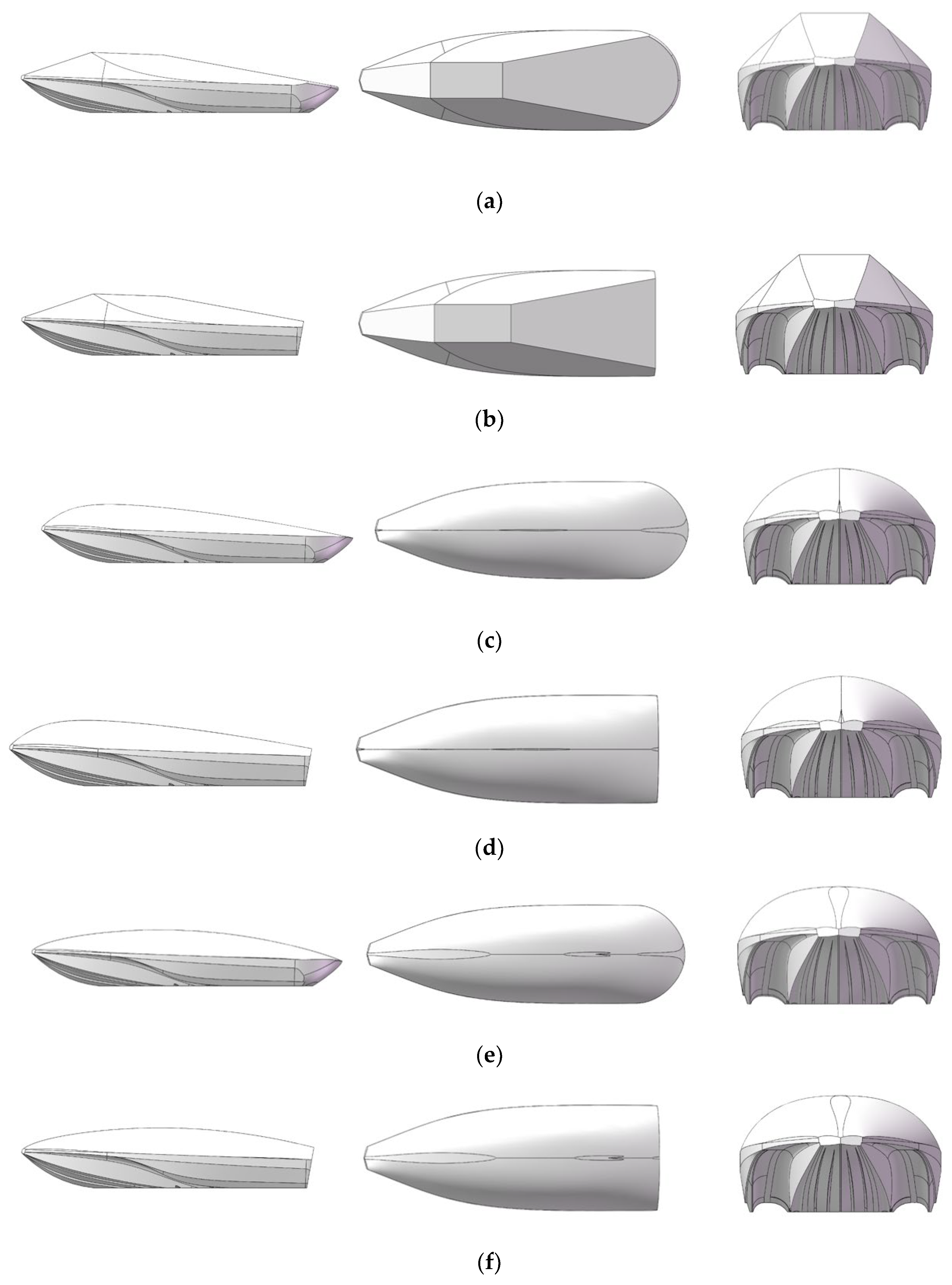
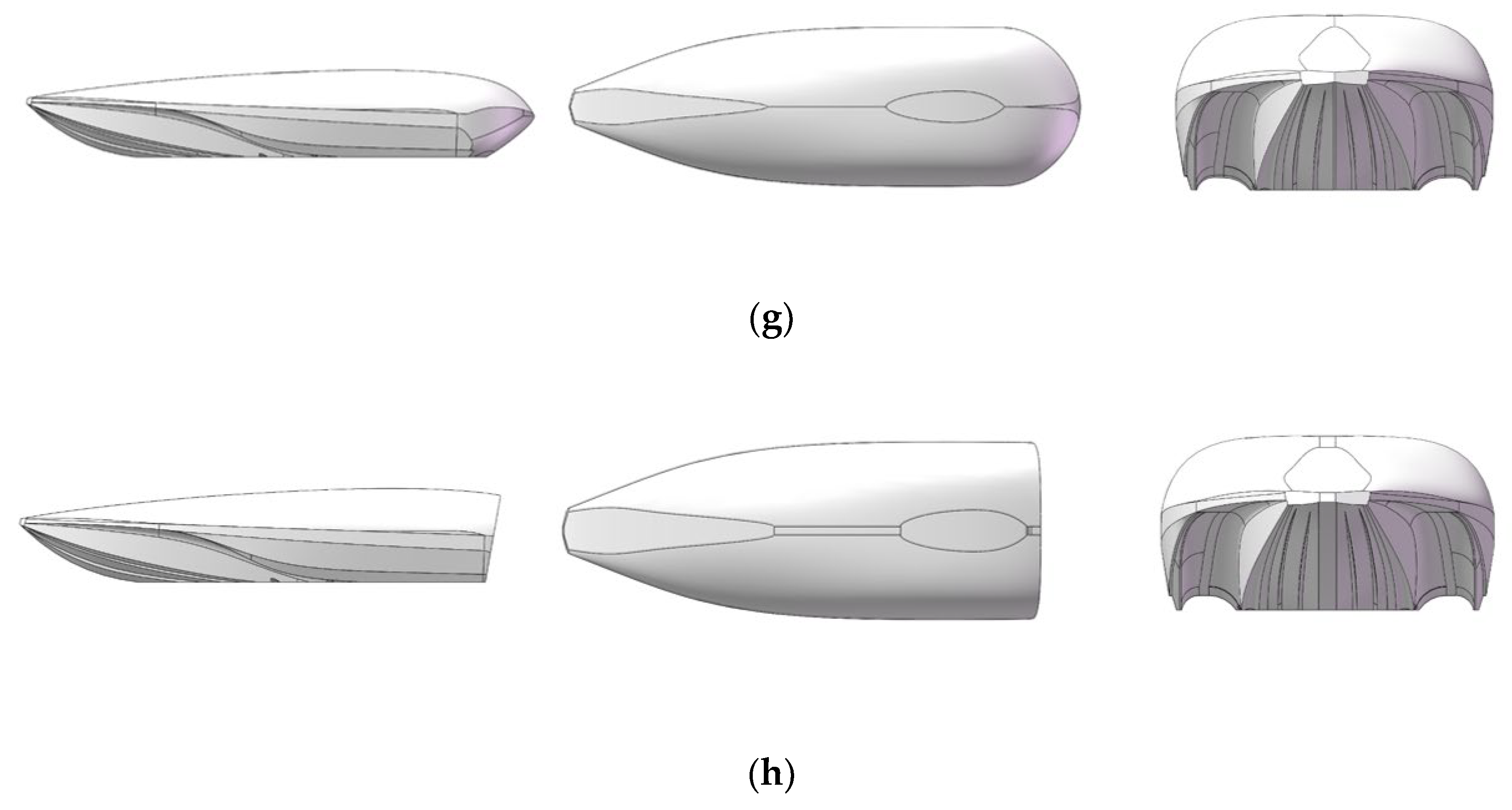

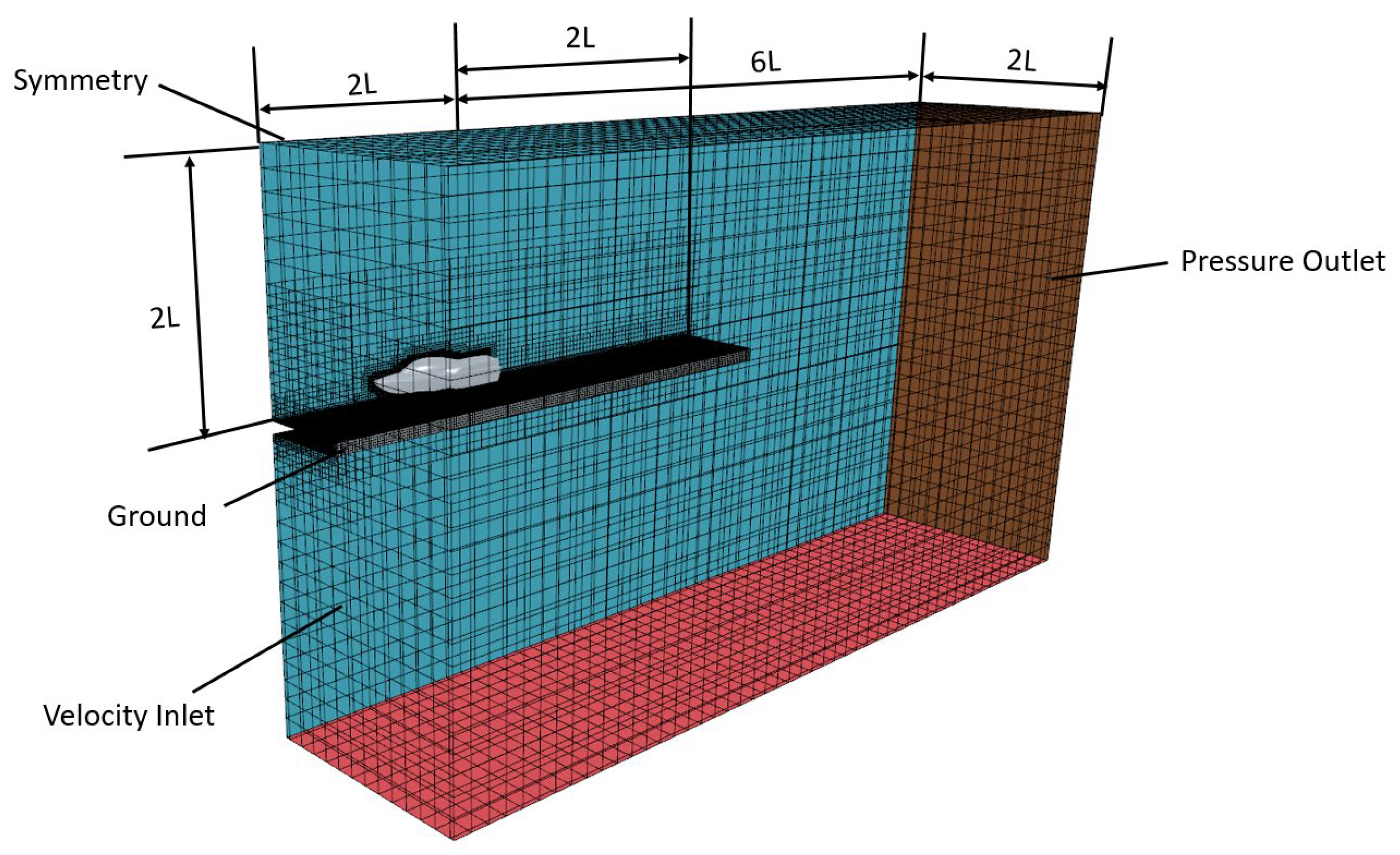
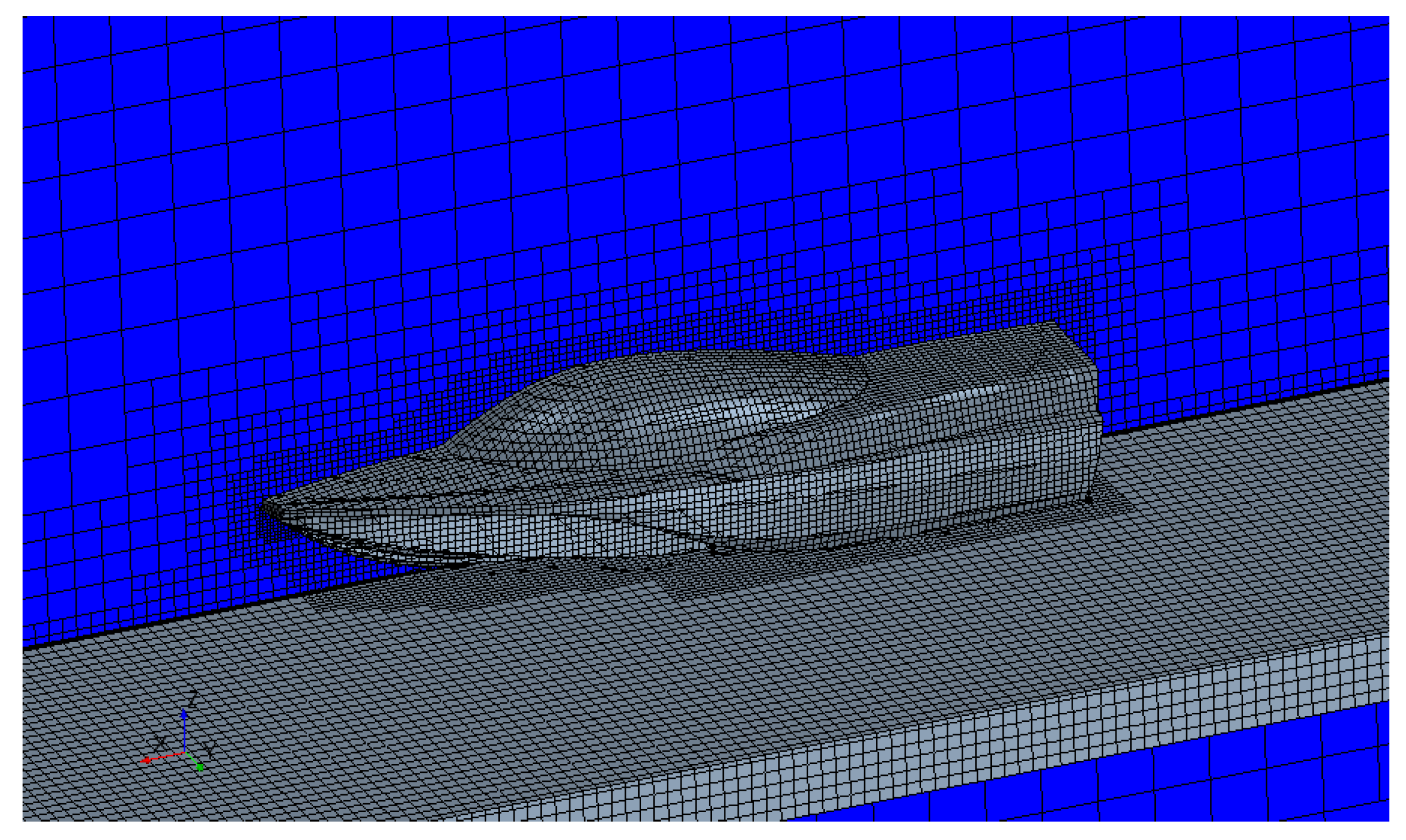
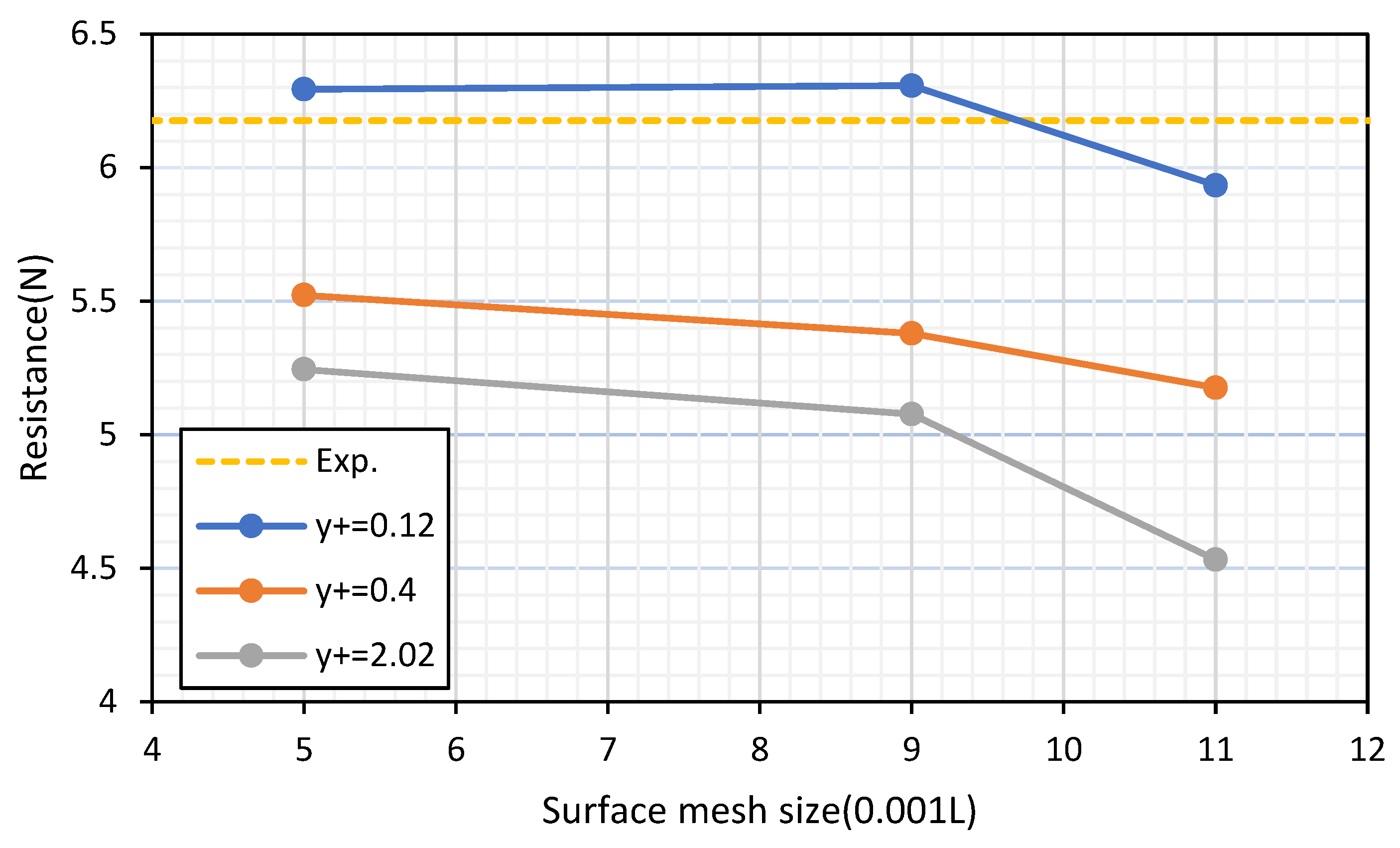
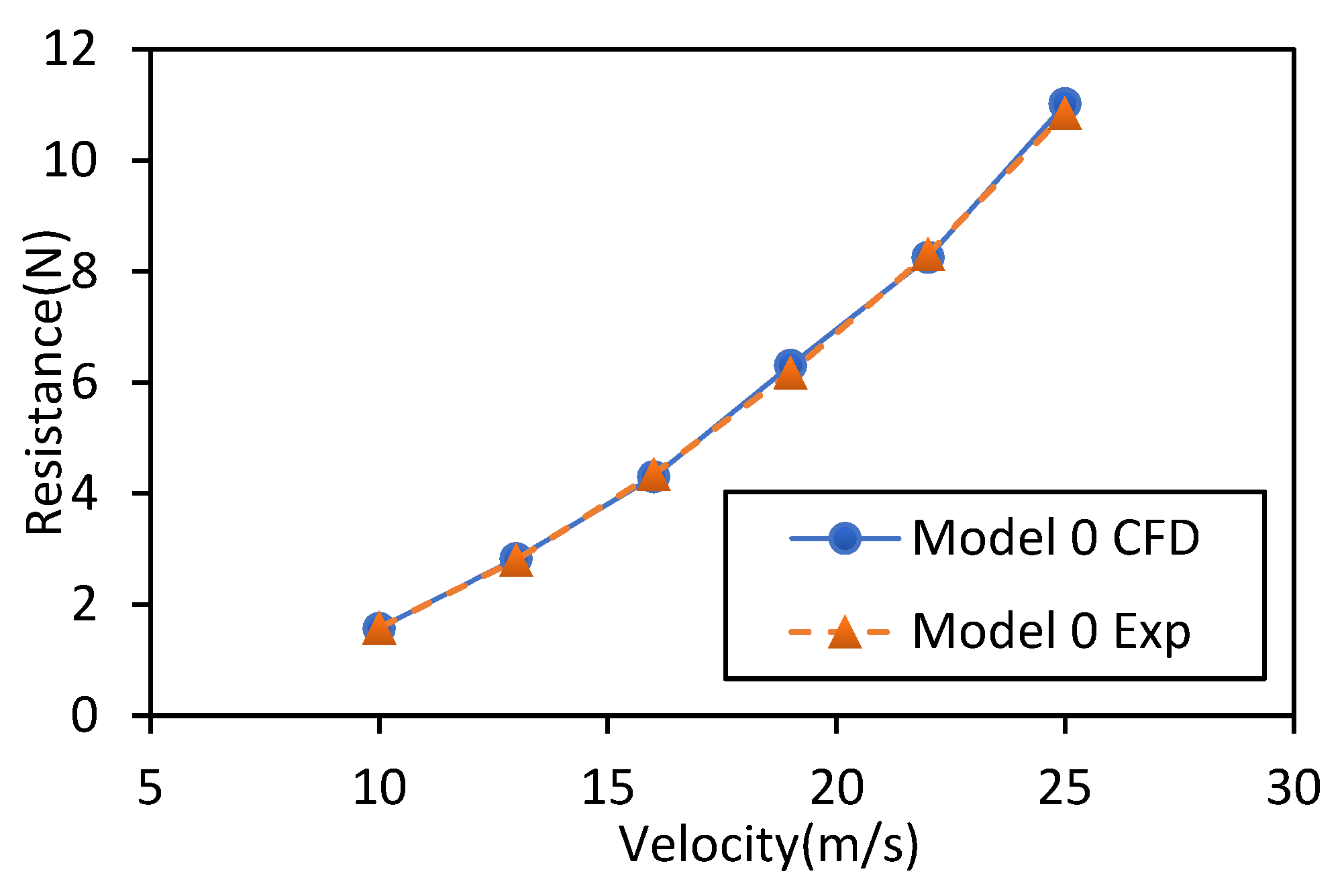
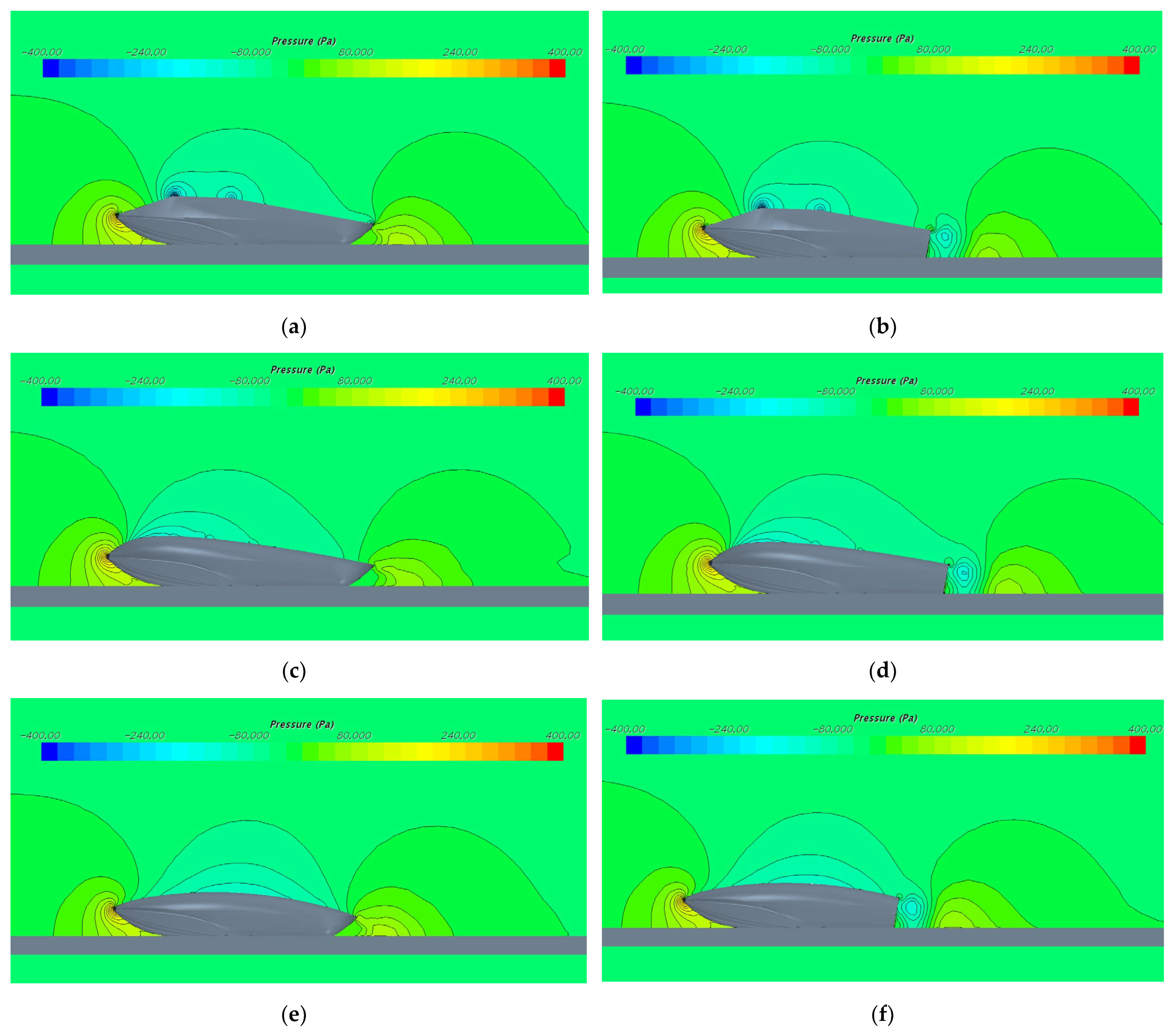

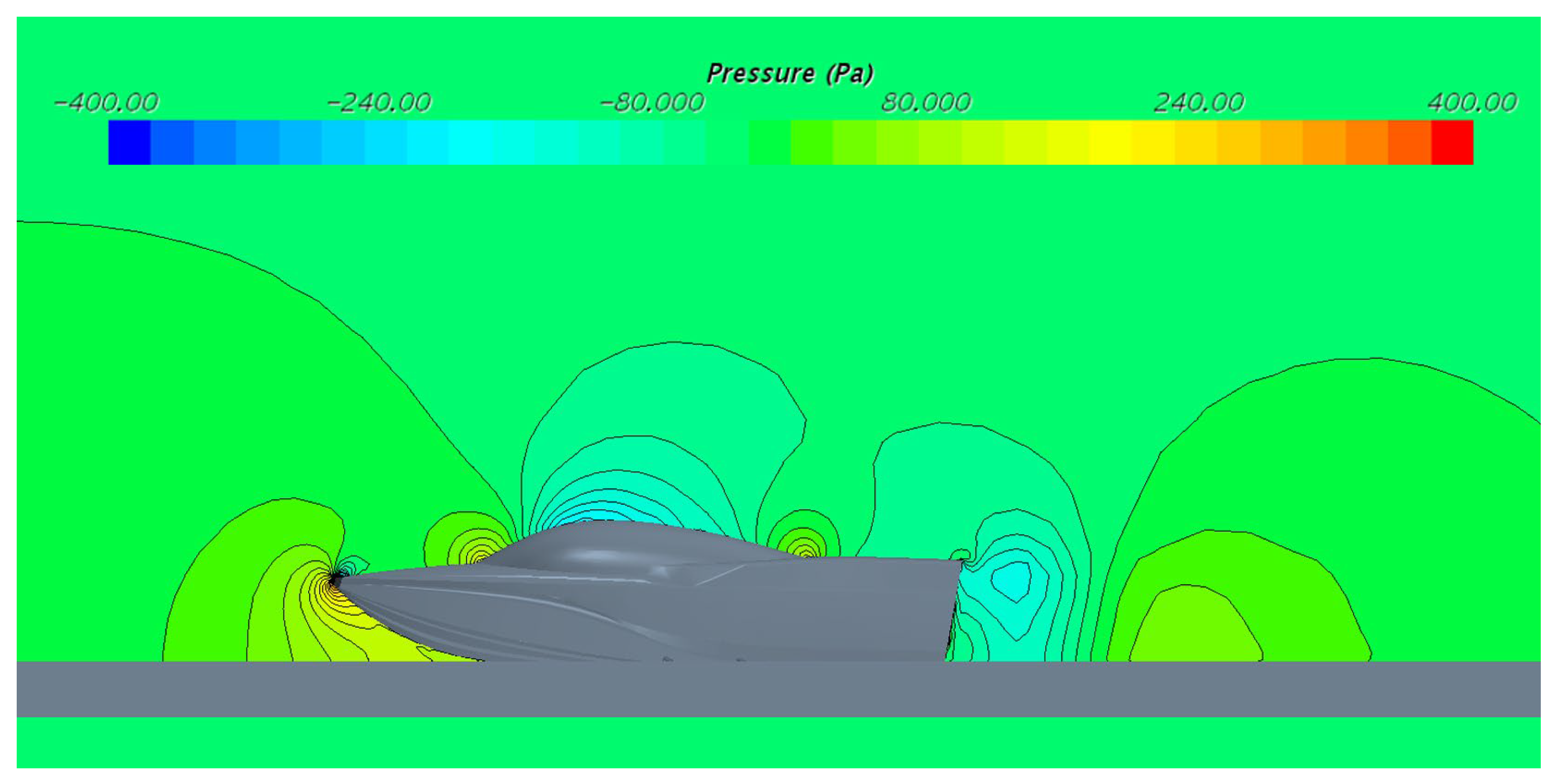
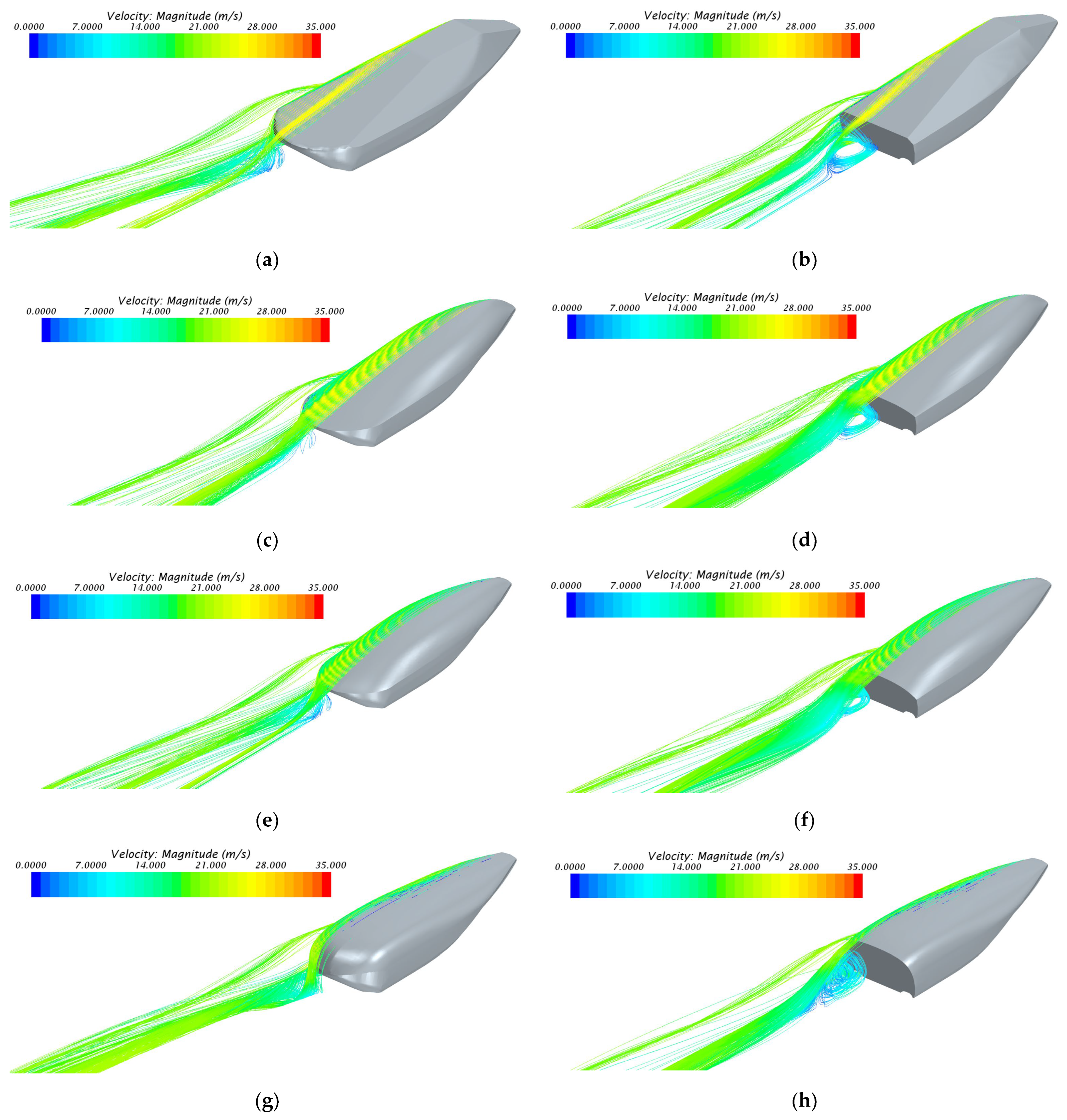
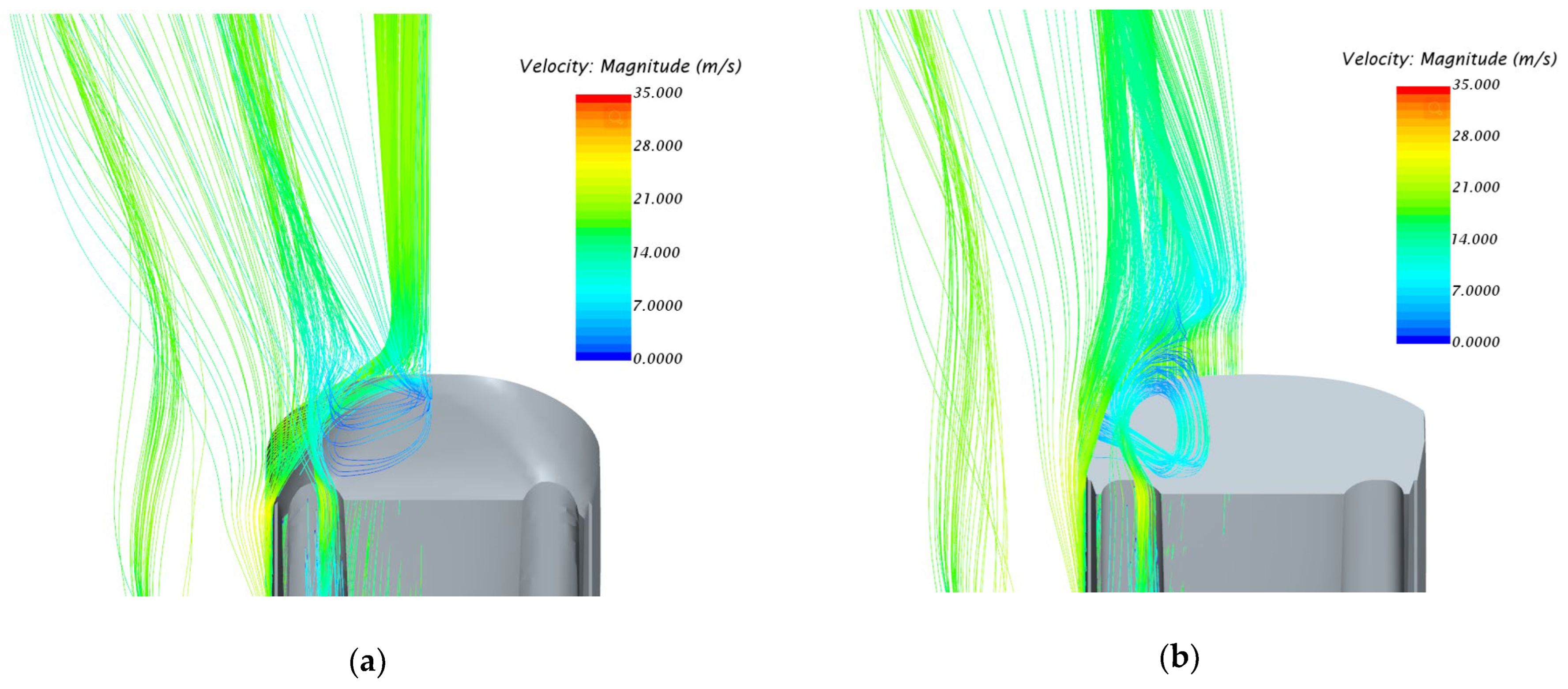
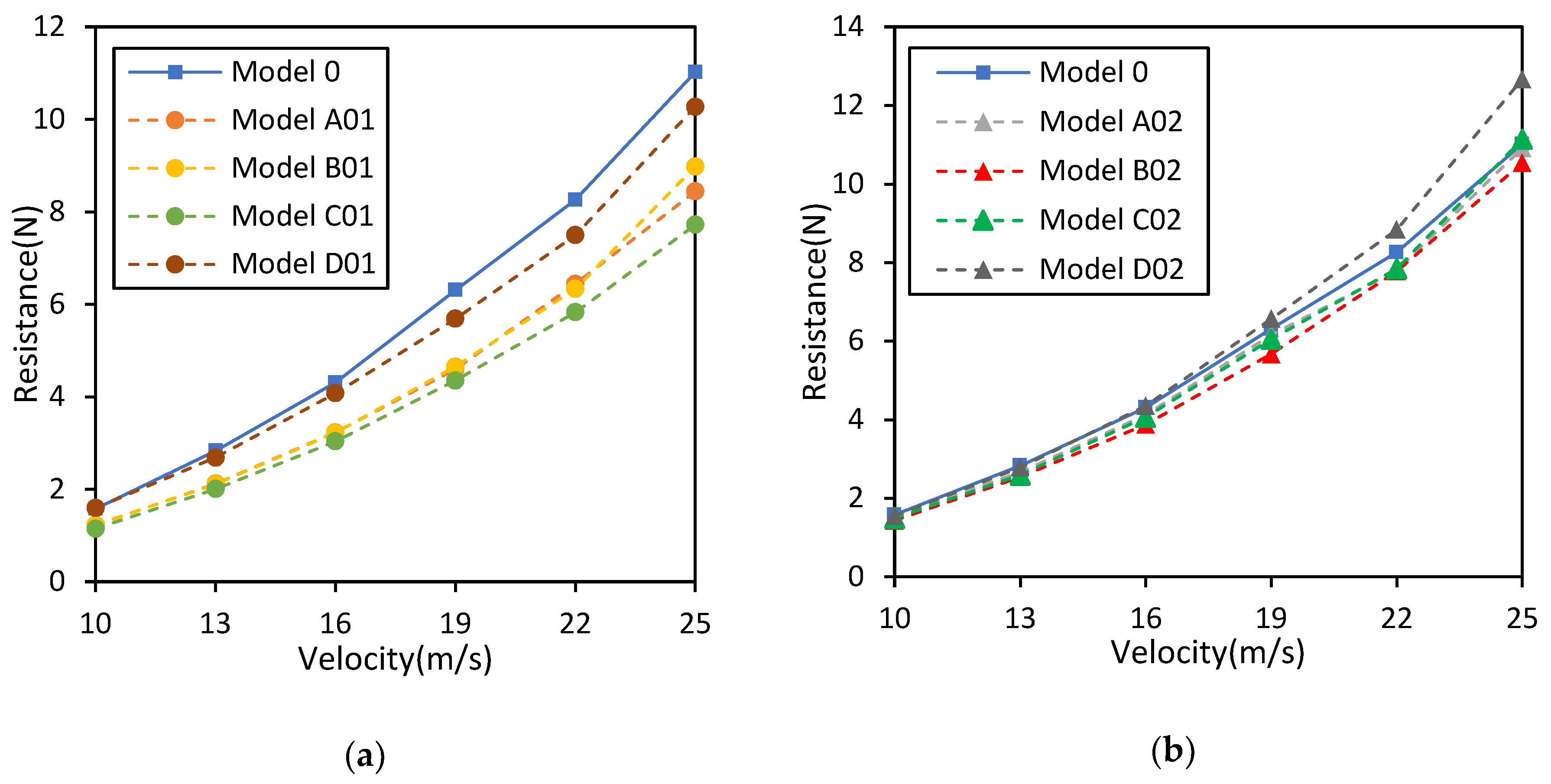
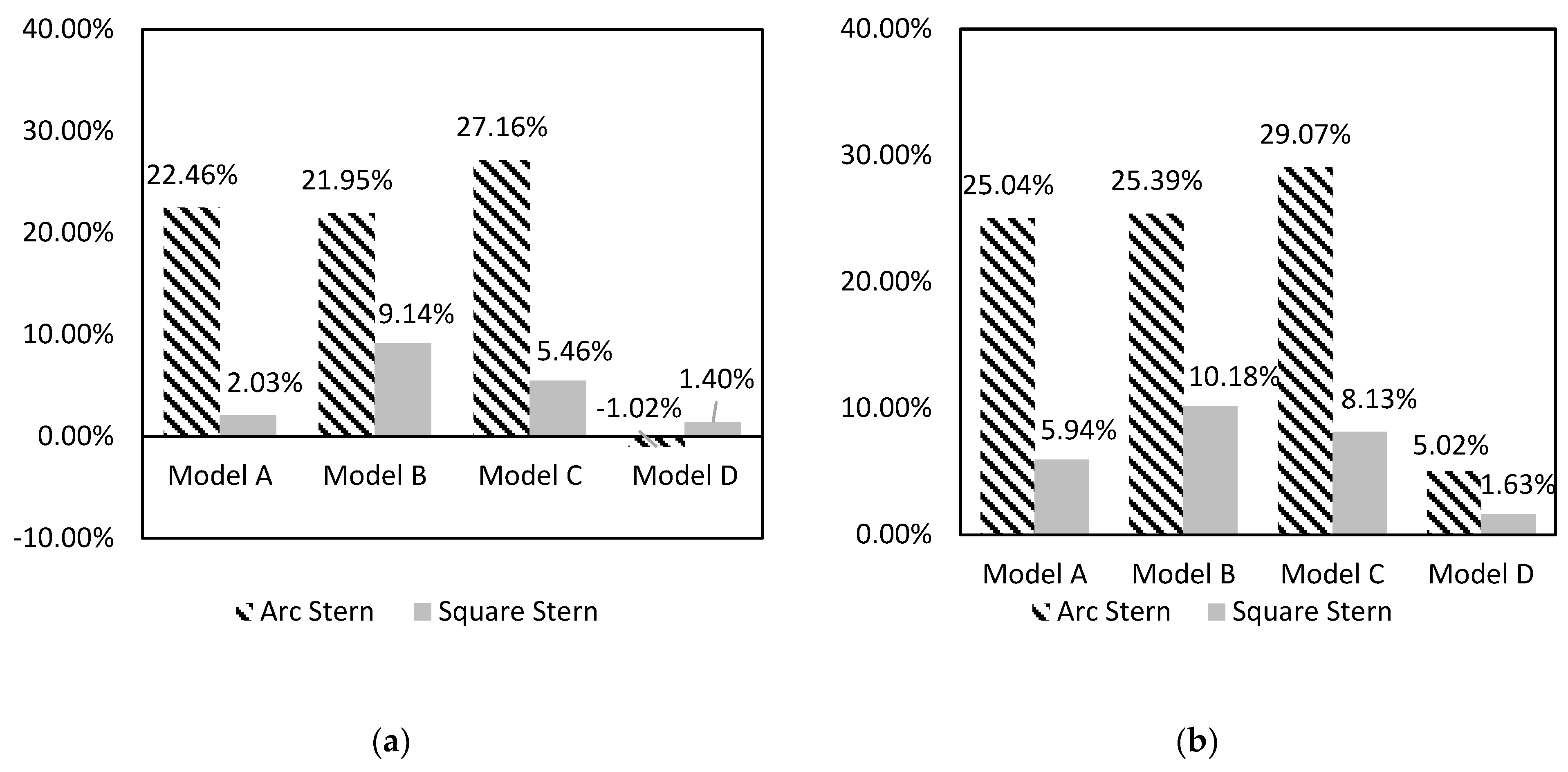
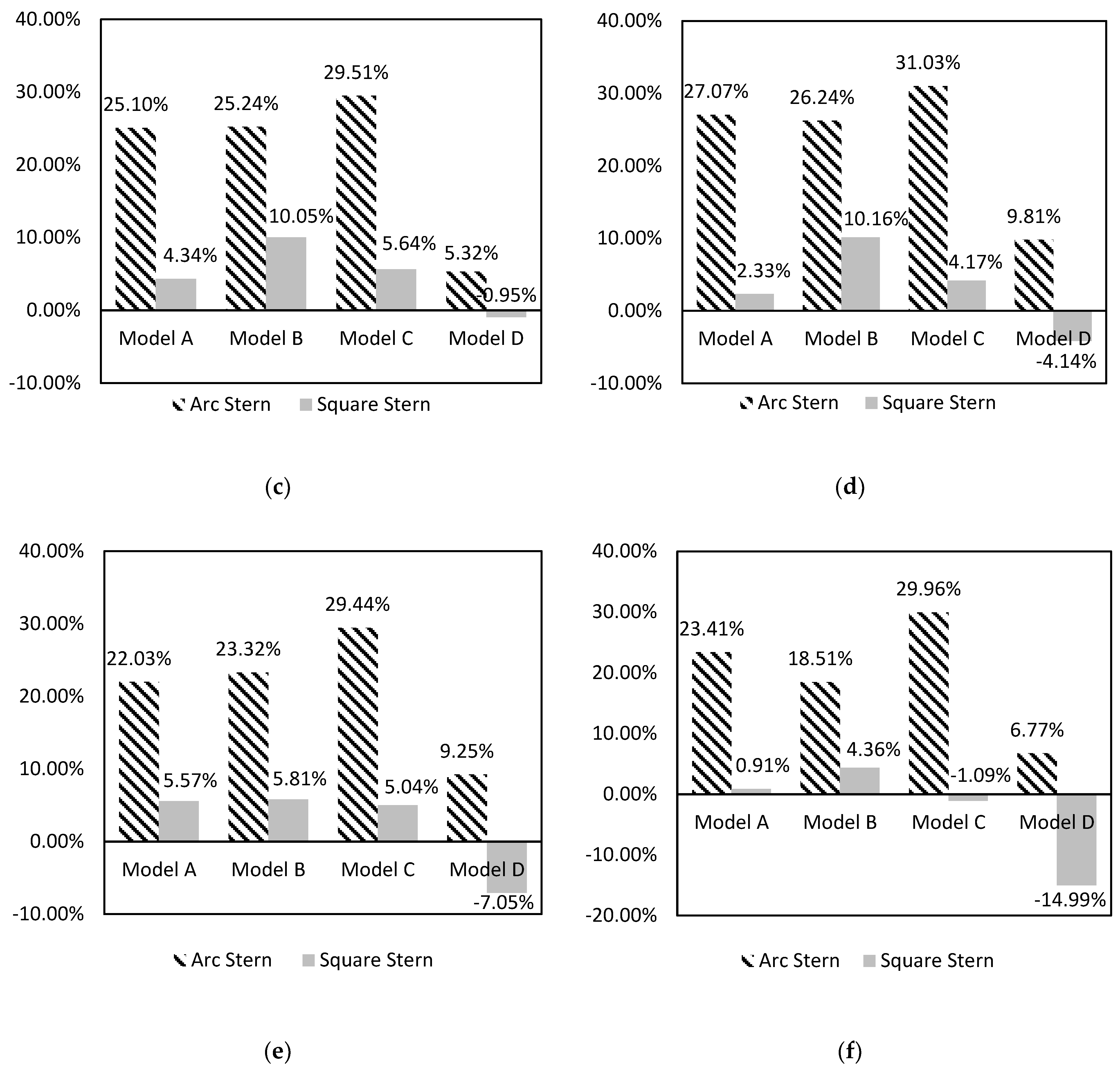
| Main Feature | Symbol | Value |
|---|---|---|
| Length (m) | L | 1.131 |
| Breadth (m) | B | 0.806 |
| Test model height (m) | H | 0.403 |
| Initial model height (m) | H0 | 0.409 |
| Draft (m) | T | 0.06 |
| Displacement (kg) | △ | 9 |
| Longitudinal center of gravity (m) | LCG | 0.403 |
| Model Number | (L1/L) × 100% |
|---|---|
| Model B02 | 70% |
| Model C02 | 45% |
| Model D02 | 10% |
| Velocity (m/s) | Resistance of Exp. (N) | Resistance of CFD (N) | Err. |
|---|---|---|---|
| 10 | 1.581 | 1.576 | 0.27% |
| 13 | 2.799 | 2.828 | 1.02% |
| 16 | 4.353 | 4.307 | 1.07% |
| 19 | 6.176 | 6.307 | 2.12% |
| 22 | 8.320 | 8.260 | 0.72% |
| 25 | 10.853 | 11.020 | 1.54% |
| Velocity (m/s) | Volume of Displacement (m3) | Fr▽ |
|---|---|---|
| 10 | 0.009 | 7.00 |
| 13 | 9.11 | |
| 16 | 11.21 | |
| 19 | 13.31 | |
| 22 | 15.41 | |
| 25 | 17.51 |
| V (m/s) | M 0 | Model A01 | Model B01 | Model C01 | Model D01 | ||||
|---|---|---|---|---|---|---|---|---|---|
| R (N) | R (N) | Drag Reduction Effect | R (N) | Drag Reduction Effect | R (N) | Drag Reduction Effect | R (N) | Drag Reduction Effect | |
| 10 | 1.576 | 1.222 | 22.46% | 1.230 | 21.95% | 1.148 | 27.16% | 1.592 | −1.02% |
| 13 | 2.828 | 2.120 | 25.04% | 2.110 | 25.39% | 2.006 | 29.07% | 2.686 | 5.02% |
| 16 | 4.307 | 3.226 | 25.10% | 3.220 | 25.24% | 3.036 | 29.51% | 4.078 | 5.32% |
| 19 | 6.307 | 4.600 | 27.07% | 4.652 | 26.24% | 4.350 | 31.03% | 5.688 | 9.81% |
| 22 | 8.260 | 6.440 | 22.03% | 6.334 | 23.32% | 5.828 | 29.44% | 7.496 | 9.25% |
| 25 | 11.020 | 8.440 | 23.41% | 8.980 | 18.51% | 7.718 | 29.96% | 10.274 | 6.77% |
| V (m/s) | M 0 | Model A02 | Model B02 | Model C02 | Model D02 | ||||
|---|---|---|---|---|---|---|---|---|---|
| R (N) | R (N) | Drag Reduction Effect | R (N) | Drag Reduction Effect | R (N) | Drag Reduction Effect | R (N) | Drag Reduction Effect | |
| 10 | 1.576 | 1.544 | 2.03% | 1.432 | 9.14% | 1.490 | 5.46% | 1.554 | 1.40% |
| 13 | 2.828 | 2.660 | 5.94% | 2.540 | 10.18% | 2.598 | 8.13% | 2.782 | 1.63% |
| 16 | 4.307 | 4.120 | 4.34% | 3.874 | 10.05% | 4.064 | 5.64% | 4.348 | −0.95% |
| 19 | 6.307 | 6.160 | 2.33% | 5.666 | 10.16% | 6.044 | 4.17% | 6.568 | −4.14% |
| 22 | 8.260 | 7.800 | 5.57% | 7.780 | 5.81% | 7.844 | 5.04% | 8.842 | −7.05% |
| 25 | 11.020 | 10.92 | 0.91% | 10.54 | 4.36% | 11.14 | −1.09% | 12.672 | −14.99% |
Disclaimer/Publisher’s Note: The statements, opinions and data contained in all publications are solely those of the individual author(s) and contributor(s) and not of MDPI and/or the editor(s). MDPI and/or the editor(s) disclaim responsibility for any injury to people or property resulting from any ideas, methods, instructions or products referred to in the content. |
© 2023 by the authors. Licensee MDPI, Basel, Switzerland. This article is an open access article distributed under the terms and conditions of the Creative Commons Attribution (CC BY) license (https://creativecommons.org/licenses/by/4.0/).
Share and Cite
Cang, J.; Zou, J.; Sun, H.; Wan, L.; Zan, L. Numerical Study on Aerodynamic Characteristics of High-Speed Planing Trimaran. Appl. Sci. 2023, 13, 3787. https://doi.org/10.3390/app13063787
Cang J, Zou J, Sun H, Wan L, Zan L. Numerical Study on Aerodynamic Characteristics of High-Speed Planing Trimaran. Applied Sciences. 2023; 13(6):3787. https://doi.org/10.3390/app13063787
Chicago/Turabian StyleCang, Jiuyang, Jin Zou, Hanbing Sun, Lei Wan, and Liru Zan. 2023. "Numerical Study on Aerodynamic Characteristics of High-Speed Planing Trimaran" Applied Sciences 13, no. 6: 3787. https://doi.org/10.3390/app13063787
APA StyleCang, J., Zou, J., Sun, H., Wan, L., & Zan, L. (2023). Numerical Study on Aerodynamic Characteristics of High-Speed Planing Trimaran. Applied Sciences, 13(6), 3787. https://doi.org/10.3390/app13063787






